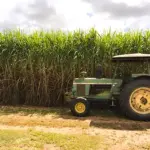A good portion of Australia’s landscape is devoted to agriculture, where broadacre farming is practised. It plays a significant role in food production and even contributes to economic growth. One very crucial factor in achieving high yield in broadacre farming is effective fertiliser application methods. Fertilisers contain necessary nutrients needed by crops to grow healthily and with correct application methods it becomes easily attainable. We are going to talk about some fertilisation techniques that work well in Broadacre farming, and we will also highlight their advantages and best practices.
When considering agricultural fertiliser application methods for broadacre farming, both fertiliser spreaders and air seeders are effective options, each with its advantages. Here’s a comparison of the two methods:
1. Fertiliser Spreaders
Overview: In the fields, such equipment known as fertiliser spreaders were designed to spread the fertiliser evenly on the farm. They can either be hitched to tractors or work alone.
Advantages:
- Efficiency: Fertiliser spreaders can cover vast farmland with ease. This is why they are ideal for broadacre farming fertilisers.
- Versatility: You can apply various fertilisers, such as granules, pellets and some liquid formulations.
- Cost-Effective: Fertiliser spreaders have a lower initial investment in general. Compared to air seeders, they are more cost-effective and can be used for different types of applications.
- Ease of Use: Most spreaders are easy to operate and calibrate, allowing for uniform distribution of fertilisers when properly set up.
Best Practices:
- Be certain that the spreader is accurately calibrated to avoid either too much or not enough application.
- When it comes to applying fertiliser, the best practice is to do it just before rain in order to increase nutrient absorption while avoiding any soil erosion through runoff.
2. Air Seeders
Overview: Air seeders are sophisticated machines that can simultaneously seed and fertilise by delivering seeds and fertilisers through a network of tubes to the soil.
Advantages:
- Precision: Air seeders allow for precise placement of fertilisers, either in bands or near the seed row, optimising nutrient uptake by crops.
- Reduced Soil Disturbance: Seeders use no- or minimum-till method, ensuring that the soil structure and health stay intact.
- Integrated Application: The integrated application of fertiliser after seeding saves you time.
- Variable Rate Technology: Many modern air seeders are equipped with technology that enables variable rate application, allowing farmers to apply agricultural fertilisers based on specific field conditions.
Best Practices:
- To maintain the optimal performance of your seeder machine, regular monitoring and calibration are important.
- Adjust the application rates based on soil tests and crop needs.
Comparison Summary
A Fertiliser Spreader would be the ideal choice for large-scale farmers if they want quick coverage and prioritise flexibility. They are easy and straightforward to use, cost-effective in nature, and work with a range of fertiliser types.
An Air Seeder offers precision by integrating seeding with fertilisation, making it an advanced tool for farmers who want to maximise nutrient uptake.
The Benefits of Using Worm Hit Fertilisers
In addition to traditional fertiliser methods, incorporating Worm Hit fertilisers can significantly enhance broadacre farming outcomes. The organic composition of Worm Hit provides an ideal fertiliser for broadacre farmers due to the worm casts, which contain naturally high levels of nitrogen and phosphorus compared to standard manure. The natural structure of Worm Hit Pellets makes it a slow-release fertiliser, ensuring that nutrients are available to crops over an extended period.
Moreover, Worm Hit’s non-toxic composition eliminates the risk of fertiliser burn, allowing for healthier plants and faster growth. When applying Worm Hit Pellets to pastures and broadacres, it is recommended to use 60 to 100 kg per hectare for establishing crops using a fertiliser spreader or air seeder. This application method not only promotes nutrient uptake but also contributes to the overall health and productivity of the crops.
By integrating Worm Hit fertilisers with effective application methods, broadacre farmers can further optimise their yields and foster sustainable farming practices.
Maximising Yield Through Smart Fertiliser Choices
Choosing the right application methods makes all the difference in maximising yield. The different techniques like fertiliser spreader and air seeder are chosen based on the specific needs of the farming operation, scale, crop type, soil conditions, and budget. In broadacre farming fertilisers, both efficiency and yield are critical which is why both the discussed methods can be equally effective. As a farmer, you may benefit by using a combination of both techniques, depending on your situation.




